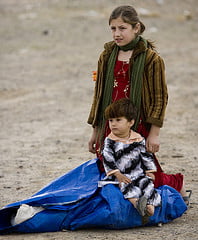New York, NY — More Afghans might die from hunger than from violence this winter.
Afghanistan’s worst drought in a decade has devastated the country’s wheat crop. At least 6 of Afghanistan’s 34 provinces will experience crisis levels of food insecurity, a designation characterized by acute malnutrition and irreversible coping strategies by affected households, between October and December of this year, according to projections by the US Agency for International Development’s Famine Early Warning System (FEWS). The World Food Programme (WFP) expects between 2.5 million and 3 million Afghans need food assistance for up to a year beginning in August.
Food security experts anticipate that commercial imports of wheat from Kazakhstan, government wheat reserves and a bilateral donation of wheat from India won’t save Afghanistan from a severe wheat shortage. Over the summer months, distressed pastoralists and famers began selling off livestock they knew they wouldn’t be able to feed in the coming months. But the money earned from those sales won’t cover the cost of wheat sold in markets during the winter.
The signs are ominous. Wheat prices in northern and central Afghanistan increased sharply over the past year. In Mazar Sharif, the largest city in northern Afghanistan, wheat prices nearly doubled between May of 2010 and May of 2011, according to FEWS. Even if local markets are well-stocked, food prices will be prohibitively high for hundreds of thousands of struggling households by the fall.
Bamiyan province in Afghanistan’s largely peaceful central region is one area facing the impending food crisis. There, aid workers worry they won’t be able to deliver aid before the few roads leading into the mountainous province are closed off by winter weather.
Abbas Daiyar, a humanitarian researcher who spent several weeks in Bamiyan over the summer, heard local residents’ concerns firsthand. “The people told me that last year, when roads were blocked for weeks in the winter, food commodity prices doubled in some districts,” he told UN Dispatch. Daiyar said some residents of rural districts were planning to spend the winter in the provincial capital to avoid food shortages and high prices in remote areas.
Hard-hit areas of the far north, where winter arrives in late October, will be virtually inaccessible by road until the spring.
The crisis couldn’t have hit at a worse time for international aid. In June, WFP announced that its operations in Afghanistan were underfunded by $220 million and the agency would be scaling back food assistance by almost fifty percent, suspending all but the most critical programs.
“We have had to make some very difficult decisions about how to refocus our work in Afghanistan because of the funding shortage,” WFP Deputy Country Director Bradley Guerrant said.
Starting in June, the agency began cutting school meals, food-for-training activities and food-for-work programs in about half of Afghanistan’s provinces. Instead of assisting 7 million Afghans in 2011, as it had planned, the agency will reach only 3.8 million by the year’s end.
Blogging about the crisis, longtime aid worker Phil Sparrow writes, “The last serious drought I know of here was in 2000-2002. The rains had failed for about 3 years, and by 2001, people were eating weeds to survive. […] And now it is all happening again. Rains failed this year; the winter was mild and short. And though now summer is over, the crunch is just beginning.”
The Afghan government, WFP and humanitarian NGOs are racing to raise funds and coordinate relief, but those efforts might still amount to too little, too late for starving Afghans.
For farmers and aid workers alike, the political dimension of the looming crisis is impossible to ignore. Sparrow writes.
Droughts don’t happen in developed countries with functional democracies. Droughts don’t happen in Australia, or in India. Or if they do, the worst that happens is that crops fail. This is because functional democracies link meteorological data with agricultural reports, civic feedback with media information, social security records with Government representation. It is linked together and decisions are made and action is taken and because of these links, people don’t die slow, anonymous deaths. Slow anonymous deaths are already happening here, and will continue to happen, because the Government is weak and such linkages are absent and because aid agencies are not empowered, nor equipped, nor present enough to make such links, take the action and halt the suffering.
The question now is: how many lives can still be saved?
